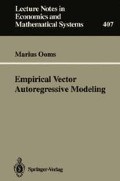Abstract
This chapter deals with the first step in the preliminary analysis of the data in order to find out whether these can be analyzed usefully in the context of a VAR model. The main aim of the VAR model in this study is to discover meaningful linear lead-lag relationships between the variables, without using too much a priori information. The bulk of the information should therefore be extracted from the data.
Access this chapter
Tax calculation will be finalised at checkout
Purchases are for personal use only
Preview
Unable to display preview. Download preview PDF.
Notes
Box and Jenkins (1970) used \(1-\phi_1L-\phi_2L^2\), which turns the triangle upside down.
A better way to generate short I(d) series is by premultiplication of a vector of white noise residuals by the square root of the theoretical covariance matrix of an I(d) series. Hosking (1981) derived the autocovariance function. Jonas (1983) discussed numerical issues of the simulation of samples from models for fractional noise.
We use the definition where the integral of the spectrum over [0,2π) equals the variance, as in (2.17) and in Granger and Newbold (1986, p. 45), so that \(f(0)=(2\pi)^{-1}\textstyle\sum^\infty_{-\infty \gamma i}\) with γi the autocovariance function at lag i. The variance of the process in (2.19) equals \(\Gamma(-2d+1)/(\Gamma(-d))^2\).
Direct use of (2.21) downweights the observations at both ends of the sample. Recent research on estimation procedures in the frequency domain suggest that this so called tapering can have advantageous effects in small samples, see Harvey (1989). See also appendix 4.2.
Seasonally integrated models do not have a summable autocorrelation function. The variance time functions and adjusted ranges correlation can only be interpreted properly if integration at the seasonal frequencies has been removed first. See chapter 4 for a discussion on seasonal integration.
Lo (1991) presented a series expansion of the cumulative distribution function of this range. For I(0)-series the statistic has mean \((\frac{1}{2}\pi)^{0.5}\), which is consistent with (2.33). The distribution of the maximum of a tied down Brownian motion is best known as the asymptotic distribution for the maximum absolute deviation Kolmogorov test statistic for empirical distribution functions, see Billingsley (1968, p. 105). The tied down Brownian motion also appears as the underlying factor in derivations of the limit distributions of test statistics for parameter stability in regression and other tests for I(0)-ness, see §3.3.6.
Tsay and Tiao (1990) generalized the set-up to multivariate models.
We do not generalize this part of the assumptions. We only work out null hypotheses where γt is integrated of order 1 at some frequencies. These tests are not valid if γt is integrated of order d, with d unequal to 0 or 1; see i.a. Dickey and Pantula (1987) for a discussion of practical consequences.
If either D0(L) or D½(L) or both factors are not present under the null, the lag order decreases to p-1 or p-2.
We present corresponding notation in the form of functionals of Brownian motions in §A6.1, where we discuss multivariate generalizations.
In chapter 4 we explain that often used seasonal adjustment filters like Census X-11 introduce seasonal unit roots in the MA parts of the ARMA representation of the series. This type of serial correlation does not fit the assumptions of many unit root tests. However, if one allows for a big enough augmentation r in the test regression, the distribution of the test statistics for integration at the zero frequency will not be affected too seriously; see Ghysels and Perron (1990).
Hylleberg et al. (1990) chose a parameterization with opposite signs for the regressors for frequencies ½ and ¼.
Converging to a normal distribution as the number of degrees of freedom tends to infinity.
Author information
Authors and Affiliations
Rights and permissions
Copyright information
© 1994 Springer-Verlag Berlin Heidelberg
About this chapter
Cite this chapter
Ooms, M. (1994). The Unrestricted VAR and Its Components. In: Empirical Vector Autoregressive Modeling. Lecture Notes in Economics and Mathematical Systems, vol 407. Springer, Berlin, Heidelberg. https://doi.org/10.1007/978-3-642-48792-7_2
Download citation
DOI: https://doi.org/10.1007/978-3-642-48792-7_2
Publisher Name: Springer, Berlin, Heidelberg
Print ISBN: 978-3-540-57707-2
Online ISBN: 978-3-642-48792-7
eBook Packages: Springer Book Archive

